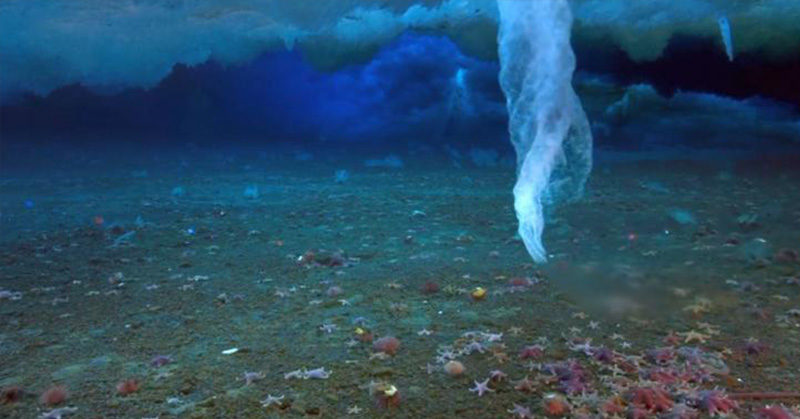In this day and age, it’s easy to think that we’ve seen everything nature could possibly have to offer- we’ve got blood moons, bioluminescent water, thundereggs, the Northern Lights, volcanic lightning– the list goes on and on.
Despite this, nature still manages to surprise and amaze us, and continues to produce natural phenomena that baffle the world’s top scientists. One such phenomenon has been known to scientists for decades, but is rarely seen: the brinicle.
The Brinicle: A Finger of Death
Scientists have been aware of the existence of brinicles since the 1960s, however catching them in action has proven to be extremely difficult.
These icy, finger-like projections found beneath the Antarctic ice shelf were first caught on camera nearly ten years ago by Hugh Miller and Doug Anderson for the Discovery Channel special series Frozen Planet.
The producer of the show Kathryn Jeffs described how the entire team was blown away by how beautiful these haunting structures were.
“We were exceptionally excited and we knew we had something that had never been filmed before, never been seen before,” she said. “No one has really seen the formation of a brinicle.” [2]
Now, for the first time ever, the formation of a brinicle has been caught live on camera by Sir David Attenborough and his team of BBC filmmakers.
What is a Brinnicle?
A brinicle, or brine-icicle, is often referred to as a “sea stalactite” because of its resemblance to stalactites that form inside caves.
Brinicles develop when sea ice forms in the Arctic and Antarctic during the winter. Ice is made up of pure water, so in order for ice to form in the saltwater ocean, it must force the salt out. This is why ice made from seawater is not as salty as the water from which it was formed [3].
The saltier the water, the colder it needs to be for that water to freeze. As salt leaks out of the forming ice, it causes the water surrounding it to become more saline, which lowers its freezing temperature and increases its density. Because of this, the water is too salty to freeze, and dense enough to sink toward the ocean floor [3].
This creates highly saline brine channels within the ice block, which is very porous. As the salty, dense water sinks downward, it freezes the water around it, which is far less salty in comparison. This is what creates that finger-like shape and appearance [4].
Dr. Andrew Thurber is a Postdoctoral Fellow supported by the National Science Foundation’s Office of Polar Programs, and is one of the few scientists who has seen brinicle growth firsthand. He describes these icy, finger-like projections as a fantastical scene.
“They look like upside-down cacti that are blown from glass,” he said, “like something from Dr. Suess’s imagination. They’re incredibly delicate and can break with the slightest touch.” [4]
Beautiful, but Deadly
Occasionally brinicles will sink all the way to the ocean floor. As this super-cooled liquid spreads, it will freeze any bottom-dwelling creatures in its path, including sea urchins and starfish.
Thurber explains that in areas where brinicles were previously located, or underneath very active ones, small pools of brine form that he and his colleagues call “black pools of death”.
“They can be quite clear but have the skeletons of many marine animals that have haphazardly wandered into them,” [4].
The Origins of Life on Earth?
The study of brinicles is still relatively new, but scientists believe that life on Earth may have originated from these icy projections. If this is the case, it could mean that they may foster conditions that are suitable for life on other planets and moons, including Ganymede and Callisto, two of Jupiter’s moons [5].
As the study of these mysterious formations continues, we will hopefully gain further insight into how they are formed and what impact they may have on our planet.

